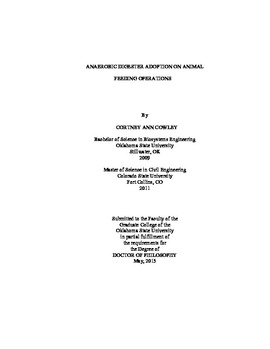| dc.contributor.advisor | Brorsen, B. Wade | |
| dc.contributor.author | Cowley, Cortney Ann | |
| dc.date.accessioned | 2016-04-15T21:49:17Z | |
| dc.date.available | 2016-04-15T21:49:17Z | |
| dc.date.issued | 2015-05 | |
| dc.identifier.uri | https://hdl.handle.net/11244/33402 | |
| dc.description.abstract | The livestock industry may create environmental problems such as nutrient pollution in water bodies and the discharge of greenhouse gases into the atmosphere, but anaerobic digestion could be a viable solution. In an anaerobic digester, microorganisms digest manure to produce biogas, which is mostly methane. While environmentally beneficial, limited economic feasibility has prevented them from being widely adopted. Most previous research on the economics of anaerobic digestion systems has been limited to site-specific case studies in the dairy industry. | |
| dc.description.abstract | The objectives of this research were 1) to determine the economic feasibility of anaerobic digesters and covered lagoons on swine operations, 2) to determine how government policies, co-product prices, peer group influence, farm characteristics, and farmer beliefs affect the decision to adopt anaerobic digesters, and 3) to develop a production function, a fixed cost function, and a variable cost function for methane production in an anaerobic digester. The objectives were accomplished by applying capital budgeting, contingent valuation, willingness-to-accept, and econometric methods to data collected from a nation-wide survey of dairy and hog producers. | |
| dc.description.abstract | Farm size and type were important variables for economic feasibility and for predicting the likelihood of adoption. Results showed that methane production exhibits increasing returns to scale, and average fixed and variable costs decrease with size. For swine farms, lower cost, passive systems, such as covered lagoons, could be a more promising investment when government grants and carbon trading are not available. Low-rate systems (e.g. plug flow and complete mix digesters) with higher capital costs are more economically feasible on dairy farms because of their increased productivity. While the environmental benefits of anaerobic digesters are important for predicting whether or not a producer will consider the technology for manure management, lower capital costs, co-product marketing, or government grants are needed in order to encourage more widespread adoption. | |
| dc.format | application/pdf | |
| dc.language | en_US | |
| dc.rights | Copyright is held by the author who has granted the Oklahoma State University Library the non-exclusive right to share this material in its institutional repository. Contact Digital Library Services at lib-dls@okstate.edu or 405-744-9161 for the permission policy on the use, reproduction or distribution of this material. | |
| dc.title | Anaerobic digester adoption on animal feeding operations | |
| dc.contributor.committeeMember | Holcomb, Rodney Brian | |
| dc.contributor.committeeMember | Campiche, Jody | |
| dc.contributor.committeeMember | Hamilton, Douglas W. | |
| osu.filename | Cowley_okstate_0664D_13822.pdf | |
| osu.accesstype | Open Access | |
| dc.type.genre | Dissertation | |
| dc.type.material | Text | |
| thesis.degree.discipline | Agricultural Economics | |
| thesis.degree.grantor | Oklahoma State University | |
